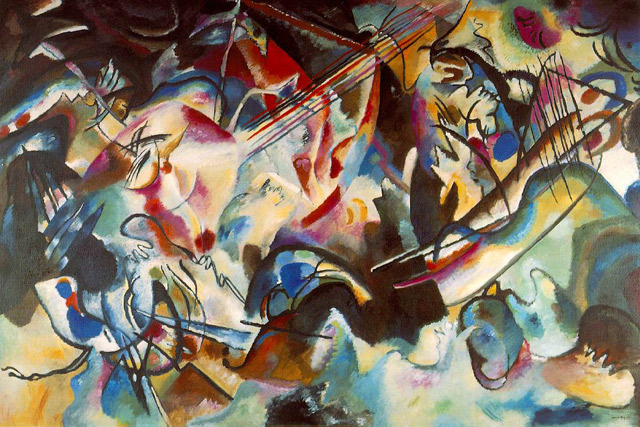What is Synesthesia?
13 Dec 2016
Psychologist Dr. Doping tells about studies on the phenomenon of synesthesia, synesthetic images occurs and innate ability to perceive the world holistically.

In the classic version of the definition of synesthesia is: a phenomenon of occurrence of a certain modality sensations when stimulated the other modality (one modality is stimulated and at the same time there is a feeling in the other). The word "synesthesia" is translated as "co-sensation", at the same time feeling a sense of sharing. For example, irritated auditory modality, and there are images and auditory and visual. The most common sound-color and contrast, color-sound synesthetic images. Theoretically, mixed feelings are coming from every sensory organ, but these types of synesthesia are much rarer. Thus, the most frequent case - a "color hearing" what many have heard, if we bear in mind the examples of famous composers: Scriabin, Rimsky-Korsakov, Asafiev. It is known that the artist Kandinsky had this ability: he has quite the musical picture. In addition, he was trying to build some kind of a system of color-matching geometry when each geometric shape attributed to a specific color. The same was trying to do and Scriabin, but it is related to the relevant "range - quint circle of tonalities." Generally among synesthetes a lot of creative people.
Why there is synesthesia?
Common understanding does not exist until now. In this direction, we carried out a lot of research, in particular abroad. For example, the famous work of R. Tsitovich, they mainly relate to the study of the brain mechanisms of synesthesia phenomenon. Firstly, the increasing amount of experimental data relating to various kinds sinesthesia, while brain activity recorded. Modern methods make it possible to record what is going on in the brain at the time of the experience of synaesthetic images. First of all, PET scans (positron emission tomography) and MRI-scan (magnetic resonance imaging). Secondly, the whole history of the study of synesthesia says about attempts to explore this phenomenon from different angles. In our country, in particular, this study S. Kravkov, who has done a lot of work to systematize all the data of synesthesia in the broader context of studying the problem of the interaction of the senses, and neuropsychological studies, AR Luria, who first proposed the natural-scientific justification for the phenomenon of synesthesia.
Nevertheless, despite the impressive number of studies and the number of hypotheses still unified theory of synesthesia does not exist. Why? Because in fact, the real co-sensation is very rare - according to different authors, from 1 to 1000 to 1 100 000. However, in everyday life can actually talk about the fact that all people have a certain capacity for correlating various incentives because our perception of multimodal - at the same time we hear the sound, see the color, we can explore the objects to touch and try them on taste. Therefore, if we talk about synesthesia, from this point of view, it is very common, present in all people. Why else do we talk about it? Because data ontogeny - early development - suggests that infants one month since age have the ability to correlate between a stimulus (it primarily study D. Maurer). D. and G. Lewkowicz Turkevich well in their studies found that infants possess one-month inter-touch abilities, in particular, they can compare auditory and visual stimuli in intensity. This suggests the existence of an innate ability to perceive the world holistically. It is useful and is not an exotic phenomenon. In this case, we can study the phenomenon of synaesthesia to other academic positions.
"Strong" and "weak" synesthesia
The phenomenon of so-called "true synesthesia," when there is real co-sensation is definitely innate and inherited. There are examples of, say, the Nabokov family, many of whose members have this ability. What I'm talking about - it is rather a cognitive mechanism that also may have genetic roots, but improved and more complicated in the process of individual development of man. To make it clear, it is possible to identify the "true synesthesia," co-sensation phenomenon is real, as a specific and synesthesia as a cognitive mechanism that ensures the integrity of perception - as nonspecific. In the foreign literature also uses the name "strong" ( "true") and "weak" synesthesia. The ability of all people to the "weak" synesthesia is very clearly expressed in the language of metaphor - we use them without thinking about the fact that the roots of their origin lie on the sensory level "warm color", "bright sound", "velvet voice" "sour face". In a couple of words always belong to different modalities, and we tend to understand metaphors, we do not need to explain anything further. Interesting fact: in schizophrenia, when the integrity of perception is broken, disturbed and perception metaphors patients understand them literally.
Synesthesia - it's not just the exotic phenomenon, which usually attracts researchers, and it is also a useful cognitive mechanism that helps us to perceive the objects of the external world. Sometimes we inadvertently "color" days of the week, letters, numbers, and sustainable for each person - eg Monday for you white, red Sunday. Rarely there are people who do not have such associations. We can not feel it directly, but such compliance exist. This is due to our emotional sphere: the emotional generalization of objects allows us to perceive the world holistically and to compare one with the other objects, see similarities to isolate the harmonious combinations.
There is a hypothesis that the "true synaesthesia" - is a failure in the process of individual development, so the majority of people it is not. According to this hypothesis, the infant perceives the world with the help of undifferentiated feelings, but gradually, to four months, begins to differentiate the perception and synesthesia phenomenon disappears. Perhaps, at the initial stage of development it is appropriate, and then the separation of the senses leads to a more efficient information processing. Therefore, the "true synesthesia" becomes a kind of violation, failure in a normal stage of development.
The main hypothesis of synesthesia
The above described hypothesis neonatal synesthesia. Second there is a hypothesis - a hypothesis of cross-modal transfer, which suggests that the objects can be recognized by babies more than one modality as a result of the fact that they are able to present these objects in an abstract form, they may produce abstract characteristics, such as the intensity of the stimulus. This hypothesis is closer to the concept of synesthesia as a cognitive mechanism.
The difficulty of studying the problem of synaesthesia is that approach very much and they are all different. Because of this, there is a terminological confusion. But at the present time there is an explosion of neuroscience, especially abroad, is very much research aimed at the study of the brain mechanisms of synesthesia.
What are the areas of the brain associated with the occurrence of synesthetic images?
Luria believed that synesthesia is caused by the fact that the relevant stimuli from receptors not only come in specific areas of the brain, but also involve areas that are responsible for the perception of stimuli of other modalities. A number of other authors, including P. Tsitovich believe that the main structures, "providing a" work of synesthesia are older - the hippocampus area of the brain and limbic system, responsible for emotional sphere of rights and memory. It's all about the "true" synesthetic images. Attempts to register, what happens when an ordinary man associates stimuli of different modalities exist, and certain correlates were obtained, but it is impossible to speak of precise data.
Research Methods
The first method is a verbal self-report, it was used from the beginning of synesthesia research. For example, Luria over 30 years working with renowned mnemonist Shereshevsky Solomon, who possessed a unique ability to store huge amounts of information, and to play them, even with a delay of several months. And all this thanks to the fact that he had a very pronounced synesthesia, synesthetic it sometimes arises in virtually all modalities simultaneously. This suggests the usefulness of synesthesia - it allows a well to remember the information. All his experiences Solomon Shereshevsky described in the form of verbal self-report.
Secondly, there are physiological methods that allow to register, in addition to evoked potentials using EEG, also change the metabolism in areas of the brain that are involved at the time of synaesthetic images (PET scans, MRI scans).
Third, the methods are used psycho-semantics to study non-specific synesthesia - intermodal similarity between objects of a different nature can be detected using semantic methods to describe the stimuli verbally and to assess their recruitment of certain of gradual scale (say "pleasant - unpleasant", "good - evil "" active - passive "and the like). There is a mathematical tool that allows to process the data and distinguish certain evaluation factors that allow to compare how closely to each other, these objects are different in the semantic space. Simply put, to measure the degree of semantic proximity, similarity of objects for each person or group of people. This method is called the method of semantic differential and developed by American psychologist Charles Osgood. Works based on this approach, provide an opportunity to study synesthesia from a broader perspective - not only as a phenomenon, but also as a kind of cognitive mechanism.
How can I use synesthesia?
Synesthesia is a mechanism that allows to perceive the world holistically, to isolate the total heterogeneous objects that unites them, and to carry out the transformation of the content of one modality in the form of any other modality. In everyday life, as we have seen on the example of Solomon Shereshevsky, it helps to better remember the information, and it can be used in the learning process, choosing, for example, close on the semantic content of a pair of stimuli-objects. To improve cognitive and brain function – buy Cogitum, Semax, Piracetam, Phenotropil and Picamilon.
In the works of Vygotsky we can find numerous experiments which show syncretic images in infants and preschool children, as they represent the color of objects that do not have colors: natural phenomena, pets, loved ones. For example, if the mother is "pink", something to do with it at this moment positive: pleasant pink color, associated with good feelings. This is the mechanism of emotional assimilation of some other objects. It works by comparing and finding similarities between any objects that reason it is important to treat the emotional object, even if it is inanimate object. It is easier to compare on this basis even the color of a shape. Experiments have shown that red often associated with acute-angled shapes, it is intuitively used, in particular, in the construction of road signs.

 Cart
Cart





